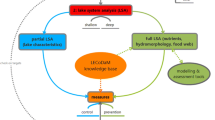Abstract
In Bautzen reservoir, a shallow, hypertrophic water in Eastern Saxony, biomanipulation led to structural changes in the phytoplankton community but did not reduce algal biomass. To supplement the top-down management, a new type of water treatment technology was tested during two seasons (May–August 1996/1997), aiming at the bottom-up control of mass developments of the cyanobacterium Microcystis aeruginosa.The technology is based on a combined lake–internal phosphorus precipitation and a transport of hypolimnetic water rich in free carbon dioxide into the upper layers. During the treatment periods, there were found both an increase of CO2concentrations in the mixed layer and an extension of the period in which free CO2was detected in the epilimnion. The concentrations of phosphorus could be lowered drastically in the whole water body. Microcystiswas almost totally suppressed (1996) or appeared with a delay (1997) compared to the regular annual pattern observed before the treatment. In contrast to the preceding year (1995), diatoms played a major role in the summer phytoplankton during the treatment years (1996/1997). The two application periods are compared with respect to the influence of meteorologically determined variables.
Similar content being viewed by others
References
Ausgewählte Methoden der Wasseruntersuchung, Vol. 1, 1976. Chemische, physikalische und elektrochemische Methoden. Gustav Fischer Verlag, Jena.
Benndorf, J., 1987. Food web manipulation without nutrient control: a useful strategy in lake restoration? Schweiz. Z. Hydrol. 49: 237–248.
Benndorf, J., 1995. Possibilities and limits for controlling eutrophication by biomanipulation. Int. Rev. ges. Hydrobiol. 80: 519–534.
Denmann, K. L. & A. E. Gargett, 1983. Time and space scales of vertical mixing and advection of phytoplankton in the upper ocean. Limnol. Oceanogr. 28: 801–815.
Drake, J. C. & S. I. Heaney, 1987. Occurence of phosphorus and its potential remobilization in the littoral sediments of a productive English lake. Freshwat. Biol. 17: 513–523.
Holm, N. P. & D. E. Armstrong, 1981. Role of nutrient limitation competition in controlling the populations of Asterionella formosaand Microcystis aeruginosain semicontinuous culture. Limnol. Oceanogr.26: 622–634.
Hosper, S. H. & E. Jagtman, 1990: Biomanipulation additional to nutrient control for restoration of shallow lakes in The Netherlands. Hydrobiologia 200/201: 523–534.
Ibelings, B.W., L. R. Mur & A. E. Walsby, 1991. Diurnal changes in buoyancy and vertical distribution of Microcystisin two shallow lakes. J. Plankton Res. 13: 419–436.
Kamjunke, N., Deppe, T. & J. Benndorf, 1998. Bacterial production under varying trophic conditions and its importance as food source for daphnids in a biomanipulated reservoir. Int. Rev. Hydrobiol. 83: 413–420.
King, D. L., 1970. The role of carbon in eutrophication. J. Wat. Pollut. Cont. Fed. 42: 2035–2051.
Klapper, H., 1992. Eutrophierung und Gewässerschutz. Gustav Fischer Verlag, Jena, Stuttgart.
Köhler, J., 1992. Influence of turbulent mixing on growth and primary production of Microcystis aeruginosain the hypertrophic Bautzen reservoir. Arch. Hydrobiol. 123: 413–429.
Lampert, W., 1982. Further studies on the inhibitory effect of the toxic blue-green Microcystis aeruginosaon the filtering rate of zooplankton. Arch. Hydrobiol. 95: 207–220.
Miersch, U., 1993. Wissenschaftliches Gutachten zur Wassergütebewirtschaftung der Talsperre Bautzen. Technische Universität Dresden, Institut für Hydrobiologie.
Nicklisch, A. & J.-G. Kohl, 1983. Growth kinetics of Microcystis aeruginosa(Kütz.) Kütz. as a basis for modelling its population dynamics. Int. Rev. ges. Hydrobiol. 68: 317–326.
Paerl, H. W. & J. F. Ustach, 1982. Blue-green algal scums: an explanation for their occurrence during freshwater blooms. Limnol. Oceanogr. 27: 212–217.
Pierce, J. & T. Omata, 1988. Uptake and utilization of inorganic carbon by cyanobacteria. Photosynthesis Res. 16: 141–154.
Schreurs, H., 1992. Cyanobacterial dominance: relations to eutrophication and lake morphology. Thesis, University of Amsterdam: 183 pp.
Shapiro, J., 1984. Blue-green dominance in lakes: the role and management significance of pH and CO2. Int. Rev. ges. Hydrobiol. 69: 765–780.
Shapiro, J., 1997. The role of carbon dioxide in the initiation and maintenance of blue-green dominance in lakes. Freshwat. Biol. 37: 307–323.
Sommer, U., 1989. Nutrient status and nutrient competition of phytoplankton in a shallow, hypertrophic lake. Limnol. Oceanogr. 34: 1162–1173.
Talling, J. F., 1976. The depletion of carbon dioxide from lake water by phytoplankton. J. Ecol. 64: 79–121.
Tilman, D., S. S. Kilham & P. Kilham, 1982. Phytoplankton community ecology: the role of limiting nutrients. Annu. Rev. ecol. Syst. 13: 349–372.
Utermöhl, H., 1958. Zur Vervollkommnung der quantitativen Phytoplankton-Methodik. Mitt. int. Verein. Limnol. 9: 1–38.
Watanabe, M. F., K. Harada, W. W. Carmichael & H. Fujiki (eds.) 1996. Toxic Microcystis. CRC Press, Boca Raton, FL: 262 pp.
Williams, T. G. & D. H. Turpin, 1987. Photosynthetic kinetics determine the outcome of competition for dissolved inorganic carbon by freshwater microalgae: implications for acidified lakes. Oecologia 73: 307–311.
Author information
Authors and Affiliations
Rights and permissions
About this article
Cite this article
Deppe, T., Ockenfeld, K., Meybohm, A. et al. Reduction of Microcystis blooms in a hypertrophic reservoir by a combined ecotechnological strategy. Hydrobiologia 408, 31–38 (1999). https://doi.org/10.1023/A:1017097502883
Issue Date:
DOI: https://doi.org/10.1023/A:1017097502883




